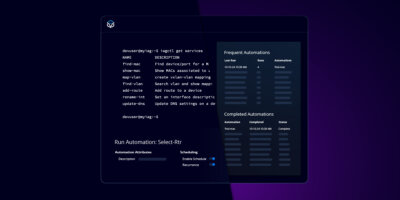We’ve seen significant evolution in network automation over the years. From the chaotic early days of TCL and Expect, to element management systems (yuck), to tools like Puppet and Chef in the early 2010s, to the world we have now: lots of code, NetDevOps building momentum, and an increasing number of network engineers building tooling using Python and Ansible.
But even with all of this progress, teams are still stuck with the same old mindset — taking existing operational best practices and turning them into automations. Something I’ve heard a lot recently is some variation of, “network automation isn’t creating as much value as we thought.” When you’re only focused on automating existing practices, you might make things faster, a little more efficient, help engineers shift their time around to stay afloat in an expanding network environment. But you’re not creating real value if that’s all you’re doing.
It’s time for a new era in network automation. It’s time for a strategic rethink. It’s time for infrastructure teams to finally break out of being merely consumers of automation and become producers, delivering standardized, efficient, productized network services to the wider organization.
Network Automation: The Story So Far…
Network automation has and continues to have a tremendous impact on the way networks are built, tested, and operated. From simple scripts to fully featured automation platforms, many organizations have tapped into the power of automation to evolve their operating models, and this will only continue as teams and organizations mature.
Historically, the drivers for network automation have been things like speed, cost, and workloads. Organizations, teams, and individuals have turned to network automation for reasons like:
- More efficient handling of long-running or time-consuming tasks.
- Reducing errors and inconsistent practices.
- Increasing network engineering and operations teams’ capacity.
- Reducing operational costs associated with running complex infrastructures.
- Improving the responsiveness and reliability of infrastructure.
As a result, most network automation successes have been rooted in domain-specific challenges and operations. Teams assess existing operational best practices and build an automation or a set of automations that can replicate that process more quickly and more reliably. Networks are often sprawling and complex, so it has been difficult for teams to move beyond this bottom-up domain-level approach to automation. When you’re just trying to stay afloat, you don’t necessarily think about what you want to do back on shore.
However, it’s important to recognize that automation can have a much greater impact than merely streamlining current processes as they exist today. The mere act of taking existing operational practices and codifying them using automation tools does not fundamentally create new value for your organization.
While it’s useful to keep doing this and making marginal efficiency gains, organizations are coming to realize that this approach to automation is not feeding into larger digital transformation initiatives enough. It’s time to take our next step forward.
From Consumer to Producer: The New Model for Network Automation
I’ll start with some basic definitions: what do I mean by ‘consumer’ and what do I mean by ‘producer?’
Automation Consumers: “I use tools to accomplish a thing.”
Personnel and systems that leverage automation to perform tasks. For most of network automation’s history, consumption has been the focus: optimizing processes to save time, reduce errors and inconsistencies, increase network reliability and uptime, and scale the network to support business needs.
Automation Producers: “I create products for other people to use.”
NetDevOps and automation personnel who build and deliver productized automation services, which can be consumed by others in the organization. Becoming a producer is about taking a product mindset, focused on making network services consumable, consistent, and scalable. You can think about something like AWS — services are defined as products that a user orders from a catalog and receives instantly.
Taking a new perspective on how to take advantage of the current investments in network automation will allow organizations to truly begin the journey to transform their infrastructure teams from being merely consumers of technology to becoming producers of products and services. In this way, infrastructure teams can begin to add new value to their organizations through the development and management of an infrastructure product catalog, all powered by the investments made in automation.
In order to achieve such lofty expectations, there needs to be a coming together of key personas within the infrastructure teams, all working jointly in a more product mindset.
The journey starts with network engineering and operations teams and their commitment to learning, deploying and operationalizing network automation. Network engineering and operations teams need to continue to invest and evolve their automation capabilities. By providing domain specific automation, the infrastructure can be more responsive to changing requirements.
At the same time, network engineering and operations teams need mechanisms in place to be able to configure and operate the infrastructure quickly and efficiently. This includes supporting a wide variety of automation tools and technologies and ensuring automation consumers can self-serve network products.
The new era of network automation will be defined by a product mindset, where producers can create productized services and deliver them efficiently for consumers to self-serve.
Enabling the Journey
At NFD 36, I talked about the launch of our new automation service, which is all about enabling this product mindset for automation teams. We’re delivering a set of capabilities that allow automation developers to focus entirely on building amazing automations, with their chosen tools, and without losing time building and managing the operational stack on top. Then, you create services around those automations and deliver them to consumers through a catalog in our cloud platform.
When we showcased our new automation service at NFD, we dove into the why, what, and how of the new era of network automation, how teams can evolve from consumers to producers, and how Itential’s automation service is designed to solve operational challenges and enable teams to make the leap forward. Watch the sessions and demos on demand here to see more.
You can also try Itential’s new Automation Service for free with our 30-day trial here – see for yourself how it can help you and your team operationalize network automation.
Later this week, I’ll be at AutoCon 2 — speaking at 9:45AM MT on Thursday.
I’ll be expanding more on this vision of automation and the evolution from consumer to producer for automation developers, and we’ll showcase more of how Itential’s technology is going to support this next era of network automation. If you’ll be at the event, be sure to stop by the Itential booth and say hi — and you can double-check any info and the agenda on this page.
See you in Denver!





